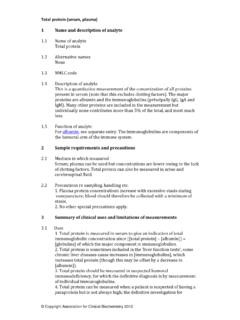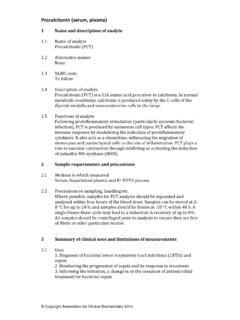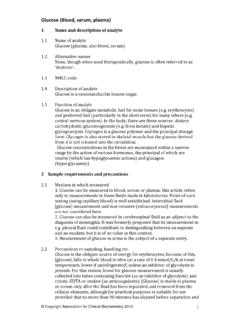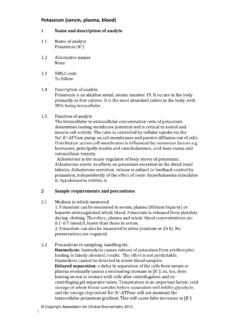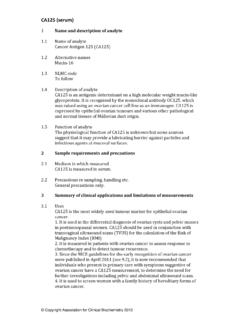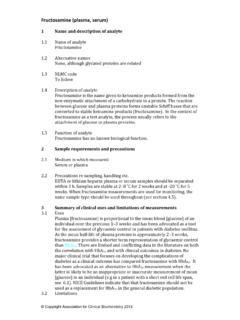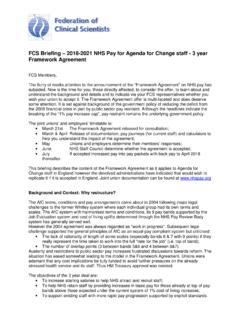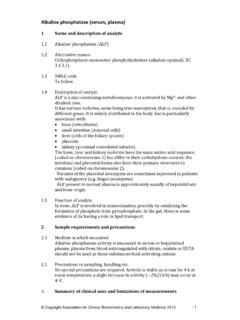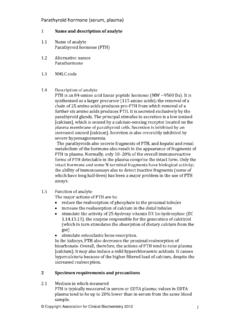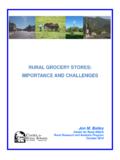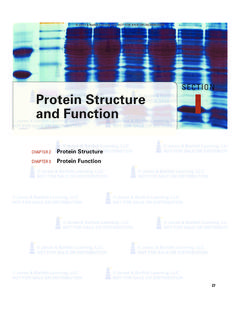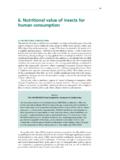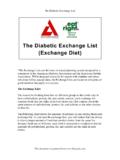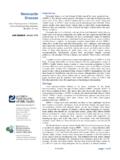Transcription of C reactive protein (serum, plasma)
1 c reactive protein (serum, plasma) 1 Name and description of analyte Name of analyte c reactive protein (CRP) Alternative names High sensitivity CRP (hs CRP) NLMC code To follow Description of analyte CRP is so named because it was first identified in the 1930s by its ability to bind the C polysaccharide antigen of the pneumococcus. It consists of a pentameric ring with each monomer containing 206 amino acid residues. It is produced by the liver in response to interleukin 6, which is released from macrophages during the inflammatory response. Function of analyte CRP binds to phosphocholine on the damaged membranes of autologous cells and to extrinsic ligands expressed by many micro organisms. It then activates the classical complement pathway and the terminal membrane attack complex.
2 It therefore has a role in innate immunity and handling of diseased tissue. 2 Sample requirements and precautions Medium in which measured Serum or plasma Precautions re sampling, handling etc. None required. CRP is stable in vitro. 3 Summary of clinical uses and limitations of measurements Uses 1. Assessment of systemic inflammation 2. Assessment of cardiovascular risk Limitations CRP is a non specific marker of inflammation so does not indicate the organ or organs affected. CRP measurements can only be used to assess cardiovasular risk status if they are made in the absence of acute inflammation. 4 Analytical considerations Analytical methods CRP is usually measured by immunoassay and a variety of assays are available. Earlier assays were used chiefly to look for the presence or absence of inflammation, and since [CRP] typically rises by a hundredfold Copyright Association for Clinical Biochemistry 2012.
3 Or more during the acute phase response, these were not required to be very sensitive. More recently, however, the identification of the importance of small, chronic elevations in [CRP] as a cardiovascular risk marker in apparently healthy individuals has led to the development of highly sensitive assays, commonly referred to as hs CRP. These use the techniques of immunonephelometry or immunoturbidimetry. Reference method There is currently no agreed reference method. The reference material (below) was certified using a combination of nephelometric and turbidometric assays from different manufacturers using a range of different platforms and reagents. A potential reference method using mass spectrometry is currently being developed by the National Institute of Standards and Technology (USA).
4 Reference material ERM/DA472/IFCC, produced by the Institute for Reference Materials and Measurements, Geel, Belgium (2009). This has a certified concentration of mg/L and is traceable to NIBSC85/506 (human c reactive protein , 1st International Standard). Interfering substances No major effects. Haemolysis, icterus and lipaemia do not affect results unless gross. Sources of error Since the range of CRP concentrations that may be encountered is wide, the high dose hook effect is a possibility at very high values. 5 Reference intervals and variance Reference interval (adults) [CRP] in healthy adults is generally very low and the distribution in a reference population is heavily skewed towards the detection limits of even highly sensitive assays.
5 Quoted upper reference limits vary depending on assay but are typically between 3 and 10 mg/L. Reference intervals (others) No significant differences Extent of variation Interindividual CV: Intraindividual CV: Index of individuality: CV of method Typically < 5% Critical difference (if assay CV 5%) Sources of variation Plasma [CRP] is affected only by the presence of inflammation. 6 Clinical uses of measurement and interpretation of results Uses and interpretation Copyright Association for Clinical Biochemistry 2012. 1. CRP measurement is used for the assessment of the presence or extent of inflammation where this is not clinically obvious. It is important to note that not every inflammatory illness requires a CRP measurement and that CRP should be requested only if the clinical picture is unclear and the result will contribute to a decision on the patient's management.
6 The half . life of CRP is a matter of hours, so that a falling [CRP] is evidence of resolution of disease, but documentation of this is not necessary if the patient's symptoms and signs are clearly improving. [CRP] rises and falls more quickly than either the ESR or [orosomucoid]. Retesting should not be at <24 h intervals. 2. [CRP] may be elevated in chronic inflammation so measurement is only of value in diagnosing exacerbations or remissions if previous results are available. 3. It is now recognised that chronic low level elevations of [CRP] in the absence of acute illness are a risk factor for cardiovascular disease and may be taken into account when assessing whether an individual requires intervention for primary prevention of this. Confounding factors Inflammation may be present at clinically unsuspected sites.
7 7 Causes of abnormal results High concentrations Causes Acute and chronic inflammation Investigation This will depend very much on the clinical circumstances. If an inflammatory illness is already clinically obvious, and measurement of CRP is requested for confirmation or to provide a baseline for monitoring, no further investigation is required. Otherwise, further investigations may include other haematological and biochemical tests, imaging and endoscopy. Whole body positron emission tomography, if available, is probably the best investigation to identify a source of inflammation when there are no other clinical pointers. Low values Not applicable Notes The use of CRP measurement as a screening test for the presence of inflammation is not advised.
8 A result within the reference range does not exclude organic disease, and the risk benefit ratio of investigating a raised result in the absence of corresponding signs or symptoms is not established. 8 Performance Sensitivity, specificity etc. for individual conditions A large number of conditions are associated with raised [CRP] but this lack of specificity means that its measurement is rarely used in isolation as a diagnostic test. However there are certain situations where it can be Copyright Association for Clinical Biochemistry 2012. helpful. It detects serious bacterial infection in children with 77% sensitivity and 79% specificity (see review by Sanders et al, section ). A [CRP] persistently >3 mg/L confers a increase in relative risk of incident cardiovascular disease compared to a value of <1 mg/L (Buckley et al.)
9 Section ). 9 Systematic reviews and guidelines Systematic reviews Numerous reviews on CRP in various conditions have been published. The following examples cover two of the more important clinical scenarios. 1. Sanders S, Marnett A, Correa Velez I et al. Systematic review of the diagnostic accuracy of c reactive protein to detect bacterial infection in nonhospitalized infants and children with fever. J Pediatr 2008;153:570 . 574. This succinct review concludes that CRP is moderately helpful for ruling in or ruling out serious bacterial infection in children. 2. Buckley DI, Fu R, Freeman M et al. c reactive protein as a risk factor for coronary heart disease: a systematic review and meta analyses for the US Preventive Services Task Force. Ann Intern Med 2009;151:483 495.
10 A comprehensive review of the evidence for CRP as a cardiovascular risk marker. Guidelines Greenland P, Alpert JS, Beller GA et al. 2010 ACCF/AHA guideline for assessment of cardiovascular risk in asymptomatic adults: executive summary. Circulation 2010;122:2748 2764. This statement recommends CRP measurement for cardiovascular risk assessment only in people at intermediate levels of risk as indicated by other factors. Recommendations None 10 Links Related analytes None Related tests The erythrocyte sedimentation rate (ESR) another non specific marker of inflammation but has generally been superseded by [CRP]. However there are a few specific conditions which are associated with a greater relative rise in ESR than [CRP], notably systemic lupus erythematosus, ulcerative colitis, temporal arteritis, polymyalgia rheumatica and multiple myeloma.
